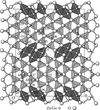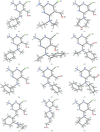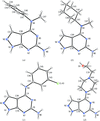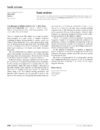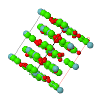issue contents
October 2008 issue

Cover illustration: The cover picture shows the strong and highly structured diffuse scattering from polymorph (II) of N-(p-methylbenzylidene)-p-methylaniline (MeMe) and indicates strongly correlated molecular motion not apparent from the Bragg analysis. Unlike polymorphs (I) and (III), which are disordered, polymorph (II) appears from Bragg scattering to be a perfectly normal ordered molecular crystal. The section of diffuse scattering data shown is part of a full three-dimensional data set recorded on beamline 1-ID-C at the Advanced Photon Source at Argonne, Illinois. Courtesy of Professor T. R. Welberry and Andrew Beasley.
research papers
Download citation


Download citation


The structure of Ga2O3(ZnO)6 is clarified using single-crystal X-ray diffraction techniques, and general rules for constructing structures in the homologous series Ga2O3(ZnO)m are presented.
Download citation


Download citation


Open  access
access
 access
accessStructural phase transitions in a crystal of (NH4)2NbOF5 are the consequence of dynamic changes in its structural units as the temperature decreases. Using X-ray diffraction, it is possible to identify O and F atoms in the disordered structure of (NH4)2NbOF5 as a result of its dynamic nature.
Download citation


Download citation


The electron-density distribution of CeB6 was measured at 340 and 535 K to determine the electron configuration of 4f and 5d orbitals, and the electron transfer from B to Ce.
Download citation


Download citation


An accurate experimental charge-density analysis is reported for the title compound, in order to gain further insights into the bonding situation in rhodium complexes. Particular focus is given to examining the interactions between the rhodium metal centre and the norbornadiene cage.
Download citation


Download citation


[(CH3)3PH]3[Sb2Cl9] experiences four phase transitions which were found by means of calorimetry, thermogravimetry and X-ray diffraction. The crystal structure was solved in the space group P63/mmc at 382 K (phase I), Pnam at 295 K (phase II) and Pna21 at 175 K (phase V).
Download citation


Download citation


The structures of three phases of the inclusion compound bis(thiourea) pyridinium iodide have been determined. Ferroelectric properties have been found in the low-temperature phases.
Download citation


Download citation


The crystal structures of phase II and the metastable phases III′ and III of cyclohexanol, C6H11OH, have been determined using high-resolution neutron powder and single-crystal X-ray diffraction techniques. Phase II crystallizes in a tetragonal structure, space group  , characterized by a hydrogen-bonded tetrameric ring motif. Phases III′ and III are monoclinic, space groups P21/c and Pc, respectively, with molecules linked via hydrogen-bonded chains.
, characterized by a hydrogen-bonded tetrameric ring motif. Phases III′ and III are monoclinic, space groups P21/c and Pc, respectively, with molecules linked via hydrogen-bonded chains.
Download citation


Download citation


Two determinations of the structure of trans/cis co-crystals of 1,4-cyclohexanediol are reported, and their intermolecular hydrogen-bond patterns described using the graph-set model.
Download citation


Download citation


A structural investigation of thiophene between 155 and 1.5 K by neutron diffraction is reported.
Download citation


Download citation


In N6-substituted 2-amino-4-chloro-5-formylpyrimidines, with three adjacent substituents on the pyrimidine ring, this ring can be planar or else puckered towards boat, screw-boat or twist-boat conformations. The supramolecular aggregation is dominated by N—H⋯N hydrogen bonds and the resulting hydrogen-bonded structures can be finite (zero-dimensional) or one-, two- or three-dimensional.
Download citation


Download citation


N4-substituted 1H-pyrazolo[3,4-d]pyrimidine-4,6-diamines can crystallize either in anhydrous form or as stoichiometric hemihydrates or monohydrates, and the hydrogen-bonded structures they form may be either two- or three-dimensional. Those examples which crystallize as hemihydrates adopt very similar supramolecular structures despite a wide diversity of N4-substituents and space groups.
Download citation


Download citation


The existence of different polymorphs for urea and barbituric acid co-crystals is explained on the basis of the resonance properties of barbituric acid (mesomeric effect). Higher-level graph-set analysis revealed a specific behaviour of the hydrogen-bond systems responsible for the mutual spatial arrangement of the structural components in the polymorphs.
Strong and highly structured diffuse scattering has been observed for form (II) of the trimorphic molecular system p-(N-methylbenzylidene)-p-methylaniline. Analysis using Monte Carlo simulation techniques has revealed highly correlated molecular motions, suggesting possible mechanisms for the transformation to the other polymorphs.
book reviews
Free 



 journal menu
journal menu











